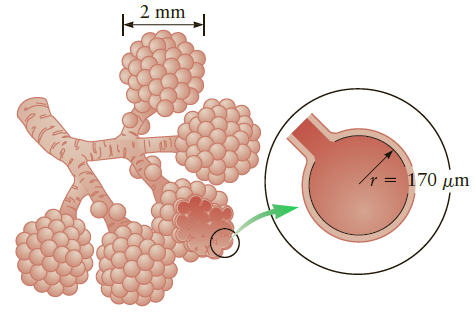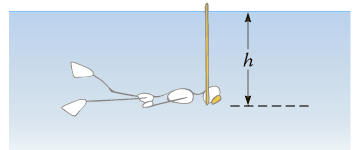Pulmonary surfactant. Oxygen enters the blood in the hollow and roughly spherical alveoli of the lungs. The
Question:
Pulmonary surfactant. Oxygen enters the blood in the hollow and roughly spherical alveoli of the lungs. The alveoli are small, approximately 170 mm in radius (Fig. P10.88), yet some 300 million of them make up 86% of the volume of each lung. The inner lining of the alveoli is, of course, wet as all living tissue must be. Thus, there is essentially a bubble of liquid just inside the lining of an alveolus having a surface tension that acts to compress the bubble, effectively generating an inward pressure that can be described by Equation 10.35. In this case, r is the radius of the sphere and Pcapis instead Pcollapse, the inward pressure on the sphere.?
(a) If the liquid lining an alveolus is pure water, what is Pcollapse??
(b) What is the ratio of this pressure to the pressure difference generated when breathing??
(c) A surfactant, a component of detergents, is a substance that greatly reduces the surface tension of a liquid. The alveoli have special cells that secrete a combination of phospholipids and proteins that give the fluid a surface tension y = 1.8 ?? 10???2 J/m2. Calculate Pcollapse for the new surface tension and compare it with the pressure difference needed for normal breathing described in Problem 84.
Figure P10.88
?
Data From Problem 84
Long snorkel. Inhalation of a breath occurs when the muscles surrounding the human lungs move to increase the volume of the lungs, thereby reducing the air pressure there. The difference between the reduced pressure and outside atmospheric pressure causes a flow of air into the lungs. The maximum reduction in air pressure that chest muscles can produce in the lungs against the surrounding air pressure on the chest and body is about 3500 Pa. Consider the longest snorkel a person can operate. The minimum pressure difference needed to take in a breath is about 200 Pa. Find the depth h that a person could swim to and still breathe with this snorkel (Fig. P10.84).
Figure P10.84

Step by Step Answer:

College Physics Reasoning and Relationships
ISBN: 978-0840058195
2nd edition
Authors: Nicholas Giordano





